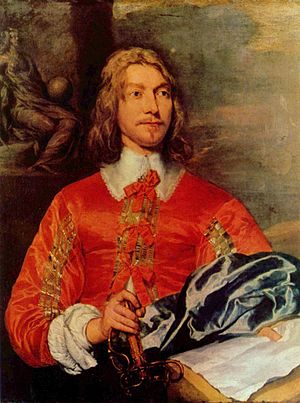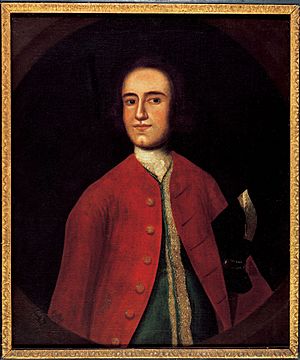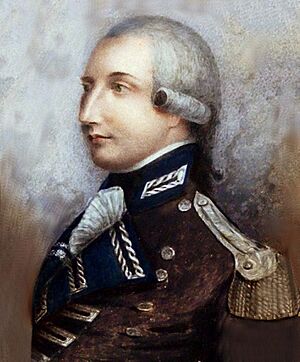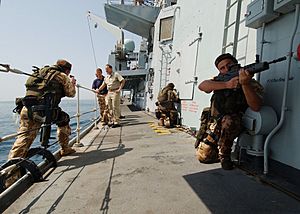History of the Royal Marines facts for kids
The Royal Marines are a special part of the British armed forces, known for their bravery and skill in fighting on land and sea. Their amazing history began way back on 28 October 1664. They were first called the Duke of York and Albany's Maritime Regiment of Foot, but soon everyone knew them as the Admiral's Regiment.
One of their most famous early achievements was during the War of the Spanish Succession in 1704. The Marines helped capture the important mole (a kind of pier or breakwater) during the attack on Gibraltar. (The sailors of the Royal Navy captured the Rock of Gibraltar itself!) Later, on 5 April 1755, a new group called His Majesty's Marine Forces was officially formed. They had fifty companies spread across three main bases: Portsmouth, Chatham, and Plymouth. They were controlled by the British Admiralty, which managed the Navy.
In 1804, a special part of the Royal Marines was created called the Royal Marine Artillery. Their job was to handle the big guns on ships called bomb vessels. Because they wore blue coats, like the Royal Regiment of Artillery, they were nicknamed the "Blue Marines." The other Marines, who wore the traditional red coats of British soldiers, became known as the "Red Marines." During the Napoleonic Wars, the Royal Marines fought in almost every major naval battle and took part in many landings from the sea. On ships, they had two main jobs: they kept order and protected the officers, and in battle, they fought the enemy, whether by shooting from their own ship or by boarding enemy ships.
During the First World War, Royal Marines served on ships as usual. But they also joined the Royal Naval Division. This division went to Belgium in 1914 to help defend Antwerp and later took part in the big amphibious landing at Gallipoli in 1915. They also played a part in the daring Zeebrugge Raid in 1918. In the Second World War, the Royal Marines' infantry battalions were changed into special Commando units, joining the British Army Commandos. Many Royal Marines also became crews for landing craft and were heavily involved in the famous D-Day invasion in June 1944.
More recently, the Royal Marines were key players in the Falklands War in 1982. When Argentina invaded the islands, a British force was sent to take them back. The Royal Marines were a huge part of this effort. They landed at San Carlos Water and then marched ("yomped") all the way across East Falkland to the capital, Stanley, which was recaptured on 14 June 1982.
Contents
How the Royal Marines Started
The very first official group of English naval infantry was formed on 28 October 1664. It was called the Duke of York and Albany's Maritime Regiment of Foot, but people soon called it the Admiral's Regiment. This group had 1,200 soldiers, who were recruited from London's local trained groups, ready for the Second Anglo-Dutch War. James, who later became King James VII & II, was in charge. He was the Duke of York and Albany, and also the Lord High Admiral.
This was the fifth marine unit formed in Europe. Other countries like Spain, the Republic of Venice, Portugal, and France had already created their own marine forces. The English regiment had six companies, each with 200 men. Its first commander was Colonel Sir William Killigrew. Many of the officers had experience serving in the Dutch army.
Another regiment, the Holland Regiment, was also created to serve at sea. Both these "Naval" regiments were paid by the Navy. A famous member of the Admiral's Regiment was John Churchill, who later became the 1st Duke of Marlborough. During the important sea battle of Battle of Solebay in 1672, a company of Foot Guards also served as Marines. The Admiral's Regiment was eventually disbanded in 1689.
In 1690, two more marine regiments were formed. These regiments took part in a landing at Cork, Ireland, on 21 September 1690, led by John Churchill. Later, in 1698, the marine forces were reorganized, but these regiments were disbanded in 1699.
In 1702, six Marine Regiments and six Sea Service Regiments of Foot were created for the War of the Spanish Succession. When fighting on land, the Marines were led by Brigadier-General Seymour. Their most important achievement was capturing the mole during the attack on Gibraltar in 1704. They then defended the fortress alongside the Dutch Marines. After the 1713 Treaty of Utrecht, three of these regiments became regular infantry units.
The Eighteenth Century Marines
Six Marine Regiments were formed between 1739 and 1740 for the War of Jenkins' Ear. Four more were raised later. One large Marine Regiment, made up of American colonists, fought alongside British Marines at the Battle of Cartagena de Indias in Colombia and Guantánamo Bay, Cuba. Among its officers was Lawrence Washington, the half-brother of George Washington. In 1747, the remaining regiments were transferred to the British Admiralty and then disbanded in 1748. Many of these former Marines were offered a new life in Nova Scotia and helped create the city of Halifax, Nova Scotia.
On 5 April 1755, His Majesty's Marine Forces were officially formed. They had fifty companies divided into three main groups, based in Portsmouth, Chatham, and Plymouth. The British Admiralty was in charge. At first, all the senior officers were from the Royal Navy, which meant Marine officers couldn't rise very high in rank. It wasn't until 1771 that the first Marine became a colonel. Throughout the rest of the 18th century, they took part in many landings around the world. One famous landing was at Bellisle off the coast of Brittany in 1761. They also fought in the American War of Independence. A group of Marines helped break the rebel resistance at the Battle of Bunker Hill. Marines also often used small boats to stop attackers when Royal Navy ships couldn't move. Captain James Cook had four Marines with him on the day he was killed in Hawaii in 1779.
Marines in New South Wales
Starting in May 1787, a group of four companies of Marines, led by Major Robert Ross, sailed with the First Fleet to establish a new colony at Botany Bay (now New South Wales, Australia). There was a mistake, and the Fleet left England without enough ammunition and tools. They got some more ammunition in Rio de Janeiro, but not all of it. This meant the Marines faced tough times after 12 months.
The First Fleet Marines had 212 members, including 160 regular soldiers. This small force was based on advice that the local Aboriginal people were few. However, when they arrived in January 1788, the Governor, Captain Arthur Phillip, found that the native population was much larger and soon began to resist the settlers. Within a year, several settlers were killed or wounded. In October 1788, the Marines were given the job of expanding the settlement from Sydney Cove to more fertile land at Parramatta.
The Nineteenth Century Marines
In 1802, King George III gave the Marines the special title of Royal Marines. This was largely thanks to Admiral John Jervis, 1st Earl of St Vincent.
The Royal Marine Artillery (RMA) was formed in 1804. Their job was to operate the big guns on bomb vessels. Before this, the Royal Artillery (Army) did it, but a court decision said army officers weren't under naval orders. Because the RMA wore blue coats like the Royal Artillery, they were called the "Blue Marines." The infantry Marines, who wore red coats, were called the "Red Marines." Sailors sometimes jokingly called them "Lobsters."
Royal Marines in the Napoleonic Wars
During the Napoleonic Wars, the Royal Marines fought in every major naval battle on Royal Navy ships. They also took part in many landings from the sea. On ships, Marines had two main roles: they kept order and protected the ship's officers, and in battle, they fought the enemy, whether by shooting from their own ship or by boarding enemy ships.
The number of Marines on a Royal Navy ship depended on its size. Generally, there was one Marine for each ship gun. For example, a large "First Rate Ship of the Line" had 104 Marines, while a 28-gun Frigate had 29. Between 1807 and 1814, there were about 31,400 Marines in total. Sometimes, regular army units had to fill in for Marines on ships because of recruitment problems.
In the Caribbean, volunteers from freed French slaves on Marie-Galante formed the 1st Corps of Colonial Marines. These men helped the British hold the island. This happened again during the War of 1812, when escaped American slaves formed the 2nd Corps of Colonial Marines. These units were led by Royal Marines officers. They fought alongside regular Royal Marines at the Battle of Bladensburg in August 1814. During this battle, a group of Royal Marine Artillery used Congreve rockets, which helped defeat the US soldiers. The Royal Marines and the 21st Regiment of Foot also took part in the Burning of Washington later that day.
A group of Marines formed from different ship detachments also fought on shore during the Chesapeake campaign. A smaller group of about 100 Marines took part in the Battle of New Orleans in January 1815. The only British success at New Orleans was an attack on the west bank of the Mississippi River by a force that included 100 Royal Marines.
Throughout the war, Royal Marines units raided towns and areas along the east coast of America, including the Penobscot River and Chesapeake Bay. They also helped capture Fort Bowyer in Mobile Bay, which was the last action of the war.
Crimean War and Beyond

In 1855, the Marine Infantry forces were renamed the Royal Marines Light Infantry (RMLI). In 1862, the name was slightly changed to Royal Marine Light Infantry. After 1850, the Royal Navy didn't see much active service at sea until 1914. They became interested in developing "Naval Brigades" for landings. In these brigades, the Royal Marines would land first and act as skirmishers (lightly armed soldiers who fight in scattered groups) ahead of sailors trained as regular infantry and artillery. This skirmishing was a traditional role for light infantry.
During the Crimean War in 1854 and 1855, three Royal Marines earned the Victoria Cross, the highest award for bravery.
For most of their history, British Marines were organized as fusiliers (soldiers armed with a type of musket). In the rest of the 19th century, the Royal Marines served in many landings, especially in the First and Second Opium Wars (1839–1842 and 1856–1860) against the Chinese. Most of these were successful, except for a landing at the Mouth of the Peiho in 1859, where Admiral Sir James Hope ordered a landing across very muddy areas.
Early 20th Century Actions
The Royal Marines also played a big part in the Boxer Rebellion in China in 1900, where another Marine earned a Victoria Cross.
For the first part of the 20th century, the Royal Marines continued their traditional role. This included providing infantry for security on ships, forming boarding parties to attack enemy ships, and carrying out small landings. Marines also traditionally manned the rear gun turrets on battleships and cruisers.
The First World War
During the First World War, Royal Marines were not only on ships but also part of the Royal Naval Division. This division landed in Belgium in 1914 to help defend Antwerp. Later, they took part in the big amphibious landing at Gallipoli in 1915. The division also fought on the Western Front. Royal Marines were the last to leave Gallipoli, replacing both British and French troops in a well-planned withdrawal from the beaches.
The Royal Marines also took part in the daring Zeebrugge Raid in 1918. Five Royal Marines earned the Victoria Cross during the First World War for their bravery.
Between the World Wars
After the war, Royal Marines were involved in the allied intervention in Russia. In 1919, the 6th Battalion RMLI had a mutiny and was disbanded. The Royal Marine Artillery (RMA) and Royal Marine Light Infantry (RMLI) were combined on 22 June 1923. After the war, the number of Royal Marines dropped sharply from 55,000 in 1918 to 15,000 in 1922. There was pressure to reduce them even further or even disband the entire Corps. As a compromise, it was decided to keep 9,500 Marines, which meant the two separate branches could no longer exist. The Marines no longer had their own artillery role, so they would rely on the Royal Artillery for support when on land. The title "Royal Marines" would now apply to everyone in the Corps. The ranks of "Private" (used by RMLI) and "Gunner" (used by RMA) were replaced by the rank of "Marine."

The Second World War
During the Second World War, a small group of Royal Marines were the first ashore at Namsos in April 1940, securing the area for a British Army landing two days later. The Royal Marines formed the Royal Marines Division, which was trained for amphibious operations. Parts of this division served in Dakar and helped capture Madagascar. When the attack on the French naval base in Madagascar was stuck, fifty Sea Service Royal Marines from HMS Ramilles, led by Captain Martin Price, were landed on the quay by the British destroyer HMS Anthony. They then captured two of the enemy batteries, which led to a quick surrender by the French.
The Royal Marines also formed Mobile Naval Base Defence Organisations (MNBDOs), similar to the United States Marine Corps Defense Battalions. One of these helped defend Crete. Royal Marines also served in Malaya and Singapore.
The first Royal Marines commando unit was formed in Deal in Kent on 14 February 1942. It was called 'The Royal Marine Commando' and later 'A Commando'. This unit took part in the Dieppe Raid. In 1942, the infantry battalions of the Royal Marine Division were reorganized into Commandos, joining the British Army Commandos. The support troops became landing craft crew and saw a lot of action on D-Day in June 1944.
A total of nine Royal Marine Commandos were formed during the war, numbered from 40 to 48. These units fought in many important campaigns:
- 1 Commando Brigade fought in Tunisia, Sicily, Normandy, and crossed the Rhineland.
- 2 Commando Brigade was involved in the Salerno landings, Anzio, and operations in Italy.
- 3 Commando Brigade served in Sicily and Burma.
- 4 Commando Brigade fought in the Battle of Normandy and in the Battle of the Scheldt on the island of Walcheren.
Royal Marines also served as pilots during the Second World War. A Royal Marines officer led the attack that sank the German cruiser Königsberg. Eighteen Royal Marines commanded Fleet Air Arm squadrons during the war.
Crews for the UK's landing craft were initially from the Royal Navy, but after April 1943, this job was given to the Royal Marines. Royal Marine officers went through special training courses.
They also provided the crews for the UK's smaller landing craft. The Royal Marines Armoured Support Group operated Centaur IV tanks on D-Day. One of these tanks is still on display at Pegasus Bridge.
Only one Marine, Corporal Thomas Peck Hunter of 43 Commando, was awarded the Victoria Cross in the Second World War for his actions in Italy. He was the most recent Royal Marine commando to receive this medal.
The Royal Marines Boom Patrol Detachment, led by Blondie Haslar, carried out Operation Frankton (a daring raid using canoes) and helped create the basis for the post-war SBS.
After 1945
In 1946, the Army Commandos were disbanded, leaving the Royal Marines to continue the commando role.
Royal Marines were involved in the Korean War. 41 (Independent) Commando was reformed in 1950. It worked with the United States Navy and later joined the US's 1st Marine Division at Koto-Ri. As Task Force Drysdale, 41 Commando fought its way from Koto-Ri to Hagaru after the Chinese blocked the road. It then took part in the famous withdrawal from Chosin Reservoir. The Marines were withdrawn from the conflict in 1951. They received the Presidential Citation from the US for their bravery.
After playing a part in the long Malayan Emergency, the next action came in 1956 during the Suez Crisis. Headquarters 3 Commando Brigade and Nos 40, 42, and 45 Commandos took part. This was the first time helicopters were used to land troops in an amphibious attack. British and French forces defeated the Egyptians, but they later withdrew due to international pressure.
In September 1955, 45 Commando was sent to Cyprus to fight against EOKA guerrillas. The EOKA was a small but strong group of Greek Cypriots who had a lot of local support. The unit launched Operation Foxhunter to destroy EOKA's main base.
More action in the Far East happened during the Indonesia–Malaysia confrontation. Nos 40 and 42 Commando went to Borneo to help stop Indonesian forces from causing problems. During this campaign, Lima Company of 42 Commando carried out a daring amphibious assault at the town of Limbang to rescue hostages. This Limbang raid led to three of the 150 Marines involved receiving awards for bravery. Lima Company of 42 Commando is still called "Limbang Company" today in memory of this raid.
In January 1964, part of the Tanzanian Army mutinied. Within 24 hours, parts of 41 Commando were flying to Nairobi, Kenya, and then traveling by road into Tanzania. At the same time, Commandos on board HMS Bulwark sailed to East Africa. The revolt was put down, and the Marines spent the next six months disarming military personnel in Tanzania.
From 1969 onwards, Royal Marine units regularly went to Northern Ireland during The Troubles. Thirteen Marines were killed in action there. Another eleven died in the Deal barracks bombing of the Royal Marines School of Music in 1989.
Between 1974 and 1984, the Royal Marines served three times with the United Nations in Cyprus. In November 1974, 41 Commando became the first commando unit to wear the light blue berets of the UN when they began their first six-month tour with the UN forces in Cyprus (UNIFCYP).
The Falklands War was the next big action for the Royal Marines. Argentina invaded the islands in April 1982. A British task force was immediately sent to take them back. Since a landing from the sea was needed, the Royal Marines were heavily involved. 3 Commando Brigade was brought to full strength, including 40, 42, and 45 Commandos, as well as two battalions from the Parachute Regiment. The troops landed at San Carlos Water and then "yomped" (marched quickly with heavy gear) across the entire island to the capital, Stanley, which fell on 14 June 1982. A Royal Marines general, Major-General Jeremy Moore, was the commander of British land forces during the war.
The main part of 3 Commando Brigade was not sent to the 1991 Gulf War. However, 24 men from K Company, 42 Commando Royal Marines, served in six-man teams on Royal Navy destroyers and frigates. They were used as ship boarding parties and took part in many boardings of suspicious ships. Other Marines also protected ships in ports throughout the Gulf. The main part of 3 Commando Brigade was sent to northern Iraq after the war to help the Iraqi Kurds as part of Operation Safe Haven.
In 1992, women were allowed to join the Royal Marine Band Service.
From 2000 onwards, the Royal Marines started changing from their traditional light infantry role with the "Commando 21" idea. This focused on protecting forces and led to the introduction of the Viking, the first armored vehicle used by the Royal Marines in 50 years.
In November 2001, after the Special Boat Service captured Bagram Air Base, Charlie Company of 40 Commando became the first British regular forces in Afghanistan. They used Bagram Air Base to support British and US Special Forces operations.
In 2002, 45 Commando Royal Marines were sent to Afghanistan, expecting heavy fighting. However, they saw little action, as no Al-Qaeda or Taliban forces were found or engaged.
3 Commando Brigade was sent on Operation TELIC, the British part of the Iraq War, in early 2003. They worked with the USMC's 15th Marine Expeditionary Unit. The Brigade carried out a landing from the sea on the Al-Faw Peninsula in Iraq to support US Navy SEALs. The 15th Marine Expeditionary Unit and 42 Commando secured the port of Umm Qasr, while 40 Commando used helicopters to secure the oil facilities. The attack went well, with few casualties. 3 Commando Brigade served as part of the US 1st Marine Division and received the US Presidential Unit Citation, which was the second time in 50 years the Royal Marines received this award.
In 2004, Iranian armed forces captured Royal Navy personnel, including six Royal Marines, on the Shatt al-Arab river between Iran and Iraq. They were released three days later after talks between the UK and Iran.
In November 2006, 3 Commando Brigade took over from the British Army's 16 Air Assault Brigade in Helmand Province, Afghanistan, as part of Operation Herrick.
In 2007, Iranian armed forces also captured Royal Navy personnel, including seven Royal Marines, when a boarding party from HMS Cornwall was seized in the waters between Iran and Iraq.
In 2008, Lance-Corporal Matthew Croucher of 40 Commando was awarded the George Cross (GC) for throwing himself on a grenade to save the lives of other Marines in his patrol in Afghanistan. Amazingly, he managed to keep his rucksack between himself and the grenade, and along with his body armor, he only suffered very minor injuries.
In 2018, women became able to apply for all roles in the British forces, including the Royal Marines, beyond the Band Service where they had served since 1992.
Where the Royal Marines are Based
When the Marines were first permanently established in 1755, they were divided into three groups based in the three main Royal Navy Dockyards: Portsmouth, Chatham, and Plymouth.
Early Bases
The Royal Marines were the first British military group to have their own barracks. Each group had one:
- The Royal Marine Barracks, Portsmouth were built in 1768. In 1848, the Portsmouth group moved to Forton Barracks in nearby Gosport.
- The Royal Marine Barracks, Chatham opened in 1779 and was used until 1950.
- The Royal Marine Barracks, Plymouth were built in 1756. Today, Stonehouse Barracks is still the main base for 3 Commando Brigade.
Later Bases
In 1805, a fourth group was created, based at Woolwich (another Royal Dockyard). The Royal Marine Barracks, Woolwich were built there between 1842 and 1848. After the dockyard closed, this group was disbanded in 1869. The buildings were given to the army and mostly torn down in 1975, but the gatehouse remains.
In 1861, the Royal Marine Depot, Deal was set up near the important naval anchorage called the Downs. It was used until 1991, though the Royal Marines School of Music stayed there until 1996.
The Royal Marine Artillery was first based at Chatham, but in 1824, they moved to their own barracks, Gunwharf Barracks, in Portsmouth. In 1858, the Royal Marine Artillery moved to Fort Cumberland, which was used for gunnery training into the 20th century. When the Royal Marine Artillery became a separate unit in 1859, Eastney Barracks was built for them, opening in 1867.
After the Royal Marine Artillery and Light Infantry combined in 1923, Forton Barracks closed. Eastney became the main base for the Corps in Portsmouth. Eastney Barracks remained the Corps Headquarters until 1995, when it was sold and turned into private homes.
|







